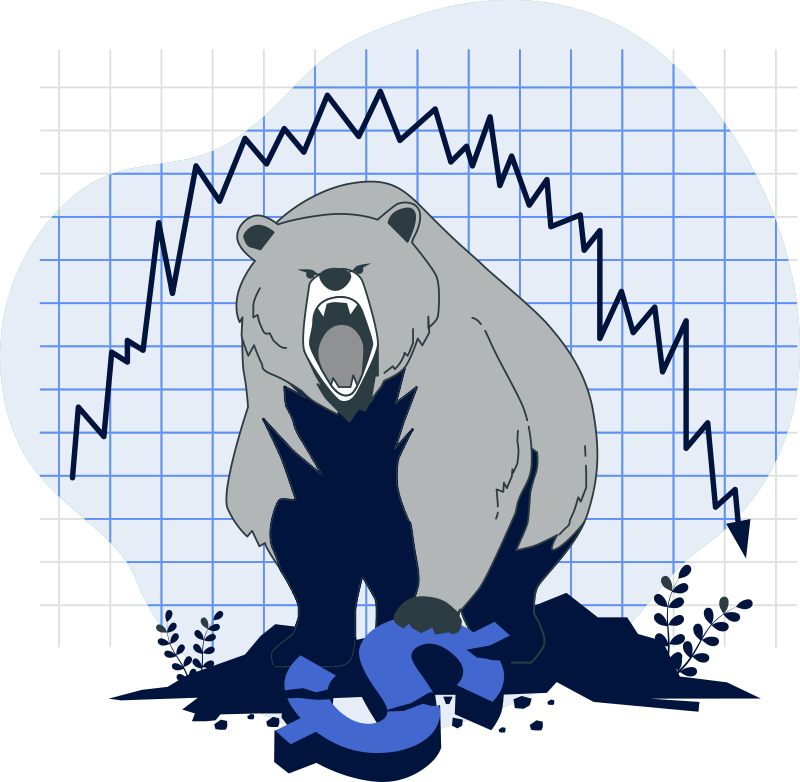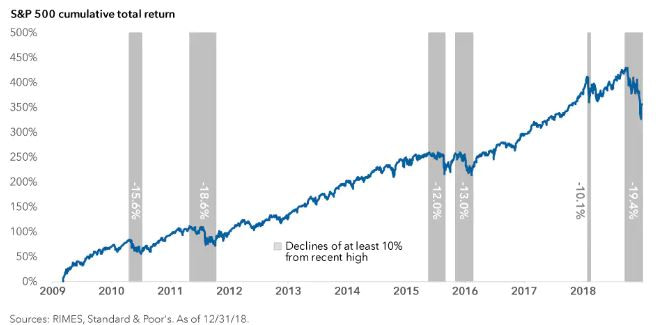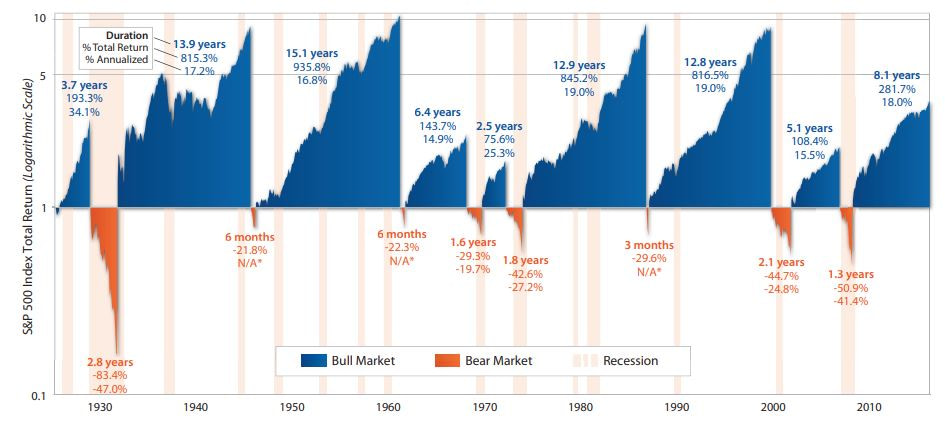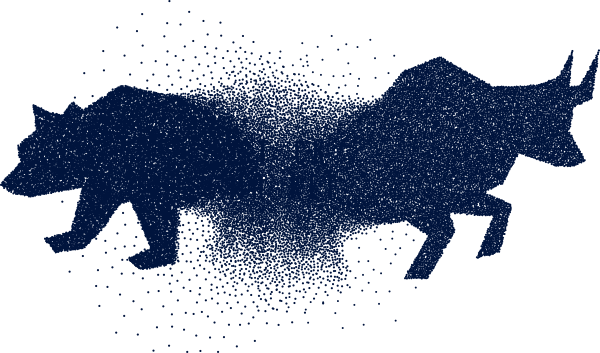US stocks entered a bear market in June 2022. But what does that mean? How much will stocks fall, and how long does a bear market last?
Of course, there are no guarantees and the future isn’t always the same as the past, but knowing more about bear markets can give us some badly needed perspective on what’s going on today.

What Is a Bear Market?
A “bear market” occurs when a market displays an extended, deep, and comprehensive price decline. The term is usually applied to stock markets, but it can also apply to commodities, real estate, or any other market.
A bear market is defined by a 20% market-wide drop in value from the most recent peak.
A bear market is only present in a general decline.
 For example, if stocks in one industrial sector experienced a large decline and other stocks were not affected, that is not considered a bear market.
For example, if stocks in one industrial sector experienced a large decline and other stocks were not affected, that is not considered a bear market.
What Is the Difference Between a Correction and a Bear Market?
A correction is a broad-scale drop in stock values of over 10%.
If major indices fall more than 10% but less than 20% before recovering, it’s called a correction. If they cross the 20% line, it’s called a bear market.
Corrections are common. Markets experience a correction around once a year, on average, and drop 5% around three times a year.

The chart above shows that five different corrections occurred during the 2009-2020 bull market.
Is a Bear Market a Recession?
A bear market and a recession are not the same things.
A recession is a slump in the general economy, including economic growth, employment, industrial production, and other factors. A bear market is defined purely by a drop in the stock market.
A bear market can cause a recession or be part of the cause of a recession. When stock markets fall investors lose money. People who have borrowed money to buy stocks may be unable to pay. Companies are less able to raise money and consumers pull back and spend less. All of these factors can contribute to a recession.
A recession or the threat of a recession can also cause a bear market. When investors see the economy in recession or sliding toward recession they will sell more speculative investments and move the money into lower-risk accounts, driving stock prices down.
How Long Does an Average Bear Market Last?
The average bear market has taken 13 months to go from the peak to the bottom and 27 months to get back to the level of the previous peak.

As we can see from the chart above, bear markets that are not accompanied by recessions tend to be relatively short and relatively mild. We can also see that bull markets tend to run much longer than bear markets.
Bull market periods show an average cumulative return of 468% and last an average of almost 9 years. Bear market periods last an average of just under 1.5 years with a cumulative average loss of 41%.
That’s why stock markets have consistently gained over the long haul despite recurring bear markets.
What Causes a Bear Market?
A bear market occurs when investors sell more stocks than they buy for an extended period. But why does that happen?
It’s important to distinguish between the trigger of a bear market and the cause.
Selling can be triggered by many causes: geopolitical events, bad economic news, indications that a recession is coming, increasing interest rates, inflation, and more.
These are triggers, not causes. Paradoxically, the cause of a bear market is usually a bull market. As we’ve seen, bull markets typically last longer than bear markets, and the gains during a bull market exceed the losses during a bear market by a large market.
The longer a bull market goes on, the more aggressive investors get. Popular stocks get bid up to unrealistic valuations. Borrowed money flows into asset markets, pushing prices higher. Market success draws new investors into play, drawn by FOMO – the fear of missing out.
This often results in a full-fledged market bubble. The bear markets of 2001, 2008-2009, and 2022 were all preceded by market bubbles. When valuations rise to completely irrational levels and debt levels peak, even a small trigger can send investors flocking to the exits. As stocks fall, fear of missing out turns into fear of getting stuck, and investors rush for the exits, sending prices down.
 Think of a bursting balloon. The pin is the trigger. The air pressure inside the balloon is the cause.
Think of a bursting balloon. The pin is the trigger. The air pressure inside the balloon is the cause.

Can Stocks Rise During a Bear Market?
Stocks can certainly rise during a bear market, just as stocks can fall during a bull market. These terms describe overall trends over extended periods. It’s common to see a brief bounce or even a few weeks of gains before stocks hit bottom.
There’s often a 10% to 20% gain near the bottom – colloquially known as a bear market rally or a “dead cat bounce” before the final plunge.

How Do We Know When a Bear Market Has Ended?
The end of a bear market is defined as the point where stocks reach the lowest point before going on to set a new high. That is an easy point to identify in retrospect, but it is impossible to identify for sure at the time.
There will be points during a bear market when major indices turn up. There is no way to know whether any such point is the end of the bear market or a dead cat bounce.
What we know is that every bear market ends and is followed by a bull market. Nobody can reliably call the top of a bull market and nobody can reliably call the bottom of a bear market. What we do know is that the more stocks fall, the closer to the bottom they get.
If you’re looking to buy at the bottom, you have to recognize that you cannot exactly identify that bottom. You will have to accept the possibility of initial losses before stocks turn up again.
How Much Do Markets Lose in a Bear Market
The average decline in major indices is 37% from peak to bottom. Historically, when stocks fall rapidly in a bear market, they are more likely to bounce back quickly.
How to Invest in a Bear Market?
You can make money in a bear market and you can lose money in a bear market.
How to Lose Money in a Bear Market
Investing is as much a psychological exercise as a financial exercise. By the time a bear market arrives, a bull market has typically been in place for some time. Investors get used to stocks going up all the time.
When stocks turn down, they tell themselves it’s temporary. As the drop continues the fear grows. At some point – analysts call it capitulation – they panic and sell everything, often at a large loss.
Then stocks turn up, and the bruised investors wait, hesitant to jump in after taking a beating. By the time they muster the courage to buy again, stocks are well on their way to another peak.
That is called selling low and buying high, and it is a great way to lose money.
How to Make Money in a Bear Market
There are many ways to successfully navigate a bear market. Different strategies are appropriate for different investors.
If you’re a relatively young investor and you’re confident in the strength of the stocks in your portfolio, it makes sense to just wait it out. Your portfolio will go down and it will go up again.
If you’re older and approaching retirement, you’ll need to take steps to protect the wealth you’ve earned.
This process starts during a bull market. As a bull market approaches maturity, you’ll see those around you taking on more risk. That’s a good time to be cautious. You’ll want to clear margin debt and avoid taking more on. It makes sense to protect more speculative positions with stop-loss orders and move money into defensive investments.
If you’ve missed the boat on that, it’s not the end of the world. Remember that the bear market will end and stocks will rise again. You might want to delay tapping your portfolio, but you certainly don’t want to sell deep in a bear market.
For active traders, there are ways to make money as stocks drop. All of these carry risks.
- Short selling involves borrowing shares and buying cheaper shares – if they fall – to pay back what you borrowed. This is a high-risk strategy and can incur large losses.
- Put options buy you the right – but not the obligation – to buy a stock at a specific price at a specific time. You can still lose, but it’s less risky than short selling.
- Inverse ETFs increase in value as an index decreases in value. If your timing is good and you buy early in a bear market, they can be profitable.
For most investors, the best way to make money in a bear market is to buy quality companies at a good price. You’ll need cash, of course, and you’ll also need a sense of timing. You’ll never call the bottom exactly, but if markets have already seen major losses and everyone around you is selling in panic, it’s probably a good time to buy!
Be fearful when others are greedy. Be greedy when others are fearful.
Warren Buffett
The post Bear Market Guide: Definition, Causes and How to Invest appeared first on FinMasters.
FinMasters